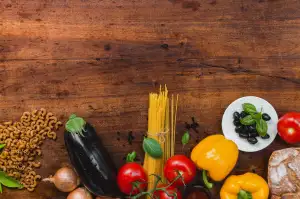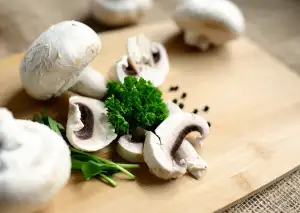Deliciously Crispy: Mastering the Art of How to Fry Chicken - A Step-by-Step Recipe Guide

Frying chicken is a culinary art that has been perfected over generations. There's something undeniably satisfying about biting into a piece of perfectly crispy, golden-brown chicken. Whether you prefer wings, drumsticks, or breast meat, learning how to fry chicken is a skill every food lover should master. In this step-by-step recipe guide, we will walk you through the process of achieving that deliciously crispy exterior while keeping the meat juicy and tender on the inside. So grab your apron and let's get started on this mouthwatering journey!
Preparing the chicken for frying
Before diving into the art of frying chicken, it's important to properly prepare the chicken. Start by selecting fresh, high-quality chicken pieces. Whether you prefer wings, thighs, or drumsticks, ensure they are clean and free from any feathers or excess fat.
Next, it's crucial to remove any excess moisture from the chicken. Pat each piece dry with paper towels to ensure a crispy exterior during frying. This step is essential as moisture can prevent the chicken from achieving that perfect golden-brown color and texture.
Additionally, if desired, you can marinate the chicken before frying to enhance its flavor. A simple marinade of buttermilk mixed with herbs and spices can work wonders in tenderizing the meat and adding extra depth of flavor. Allow the chicken to marinate for at least 30 minutes or up to overnight in the refrigerator.
By taking these preparatory steps, you'll set yourself up for success when it comes time to fry your chicken to perfection.
Seasoning the chicken
Seasoning the chicken is a crucial step in achieving that perfect flavor and tenderness. Start by generously sprinkling salt and pepper all over the chicken pieces. This will enhance the natural flavors of the meat. For added depth, you can also use a combination of herbs and spices such as paprika, garlic powder, onion powder, and dried thyme. Rub the seasoning mixture onto the chicken, making sure to coat each piece evenly. Allow the chicken to marinate for at least 30 minutes or overnight in the refrigerator for maximum flavor infusion. The longer it marinates, the more flavorful it will be when fried.
Coating the chicken with flour
Coating the chicken with flour is a crucial step in achieving that perfect crispy texture. Start by placing all-purpose flour in a shallow dish or bowl. You can also add some salt, pepper, and your favorite spices to the flour for added flavor.
Next, take each piece of seasoned chicken and dip it into the flour mixture, making sure to coat it evenly on all sides. Gently shake off any excess flour before moving on to the next piece.
For an extra crispy coating, you can repeat this process by dipping the floured chicken back into the flour mixture and coating it again. This double coating technique creates a thicker crust that turns beautifully golden brown when fried.
Once all the chicken pieces are coated, set them aside on a plate or wire rack while you prepare the oil for frying. The flour coating not only adds flavor but also helps to seal in moisture, ensuring juicy and tender meat inside.
Remember to handle the coated chicken gently to avoid knocking off too much of the flour coating. Now that your chicken is perfectly coated, it's time to move on to heating up the oil for frying.
Heating the oil for frying
Heating the oil for frying is a crucial step in achieving that perfectly crispy and golden brown exterior of fried chicken. The type of oil you use can greatly impact the flavor and texture of the chicken, so it's important to choose wisely. A high smoke point oil like vegetable or canola oil is ideal for frying.
To heat the oil, pour enough into a deep skillet or Dutch oven to submerge the chicken pieces completely. You'll want about 2-3 inches of oil in the pan. Place the pan over medium-high heat and allow it to come up to temperature. A candy thermometer can be helpful here, as you'll want the oil to reach around 350°F (175°C).
It's important not to overcrowd the pan with too many chicken pieces at once, as this will lower the temperature of the oil and result in greasy chicken. Fry in batches if necessary, ensuring there is enough space between each piece for even cooking.
As you wait for the oil to heat up, prepare a wire rack lined with paper towels or a baking sheet topped with a cooling rack nearby. This will be used later to drain excess oil from the fried chicken.
Once your oil has reached the desired temperature, you're ready to move on to actually frying the chicken.
Frying the chicken
Frying the chicken is the most crucial step in achieving that perfect crispy and golden exterior while keeping the meat tender and juicy on the inside. Once you have seasoned and coated the chicken, it's time to get frying!
1. Heat a large skillet or deep fryer with enough oil to submerge the chicken pieces completely. The oil should be heated to around 350°F (175°C) for optimal results.
2. Carefully place a few pieces of chicken into the hot oil, making sure not to overcrowd the pan. Overcrowding can lower the temperature of the oil and result in greasy chicken.
3. Allow the chicken to cook undisturbed for about 5-7 minutes on each side, depending on the size of the pieces. Larger cuts may require additional cooking time.
4. Use tongs or a slotted spoon to gently flip the chicken halfway through cooking to ensure even browning on both sides.
5. Keep an eye on the temperature of the oil throughout frying, adjusting heat as needed to maintain a consistent temperature.
6. Cook until the chicken reaches an internal temperature of 165°F (74°C) for safe consumption.
7. Remove each piece from the hot oil and place them onto a wire rack or paper towel-lined plate to drain excess oil.
Remember, always exercise caution when working with hot oil to avoid any accidents or burns. Frying times may vary depending on personal preference and equipment used, so adjust accordingly until you achieve your desired level of crispiness.
Now that your fried chicken is perfectly cooked, it's time to move on to serving and enjoying this delicious dish!
Monitoring the cooking process
Monitoring the cooking process is crucial to achieving perfectly fried chicken. Once you have placed the chicken in the hot oil, keep a close eye on it. Maintain a medium-high heat and ensure that the oil is bubbling gently around the chicken. If the heat is too high, the chicken will burn on the outside while remaining undercooked inside. If the heat is too low, the chicken will absorb excess oil and become greasy. Use tongs or a slotted spoon to turn the chicken pieces occasionally for even browning. The chicken should cook for about 12-15 minutes until golden brown and crispy. Adjust the heat as needed to maintain consistent frying temperature throughout the process.
Draining the fried chicken
After the chicken is cooked to a golden brown and crispy perfection, it's important to drain off any excess oil before serving. This step ensures that the chicken remains deliciously crispy without being greasy.
To drain the fried chicken, carefully remove each piece from the hot oil using tongs or a slotted spoon. Place the chicken on a wire rack or a plate lined with paper towels. The wire rack allows air to circulate around the chicken, preventing it from becoming soggy.
Allow the chicken to rest and drain for a few minutes. This allows any remaining oil to drip off, leaving you with perfectly crispy and flavorful chicken. Patience is key during this step as rushing may cause the coating to become soggy.
While the chicken is draining, resist the temptation to cover it with foil or place it in a closed container. Doing so can trap steam and moisture, resulting in a loss of crispiness.
Once fully drained, transfer the fried chicken to a serving platter or individual plates. Serve immediately while still hot and crispy for maximum enjoyment. Pair it with your favorite side dishes like mashed potatoes, coleslaw, or cornbread for a complete meal.
Remember, proper draining is essential for achieving that irresistible crunch in every bite of fried chicken. Don't skip this step and savor the mouthwatering results!
Serving and enjoying the fried chicken
Once the chicken is perfectly fried to a golden brown, it's time to serve and enjoy this deliciously crispy dish. Place the fried chicken on a wire rack or paper towels to drain any excess oil. This will help maintain its crispiness. Serve the chicken hot with your favorite sides such as mashed potatoes, coleslaw, or cornbread. The combination of the juicy meat and crunchy exterior is simply irresistible. Don't forget to garnish with fresh herbs like parsley or cilantro for an added burst of flavor. Gather your friends and family around the table and savor every bite of this mouthwatering fried chicken recipe. It's guaranteed to be a crowd-pleaser!
Tips and variations for frying chicken
1. Experiment with different seasonings: Besides the classic salt and pepper, try adding herbs like thyme, rosemary, or paprika to enhance the flavor of your fried chicken.
2. Marinate the chicken: For an extra burst of flavor, marinate the chicken in buttermilk or a mixture of yogurt and spices before coating it with flour. This will tenderize the meat and infuse it with delicious flavors.
3. Double dip for extra crispiness: To achieve an even crunchier coating, dip the seasoned chicken into the flour mixture once, then back into the buttermilk or egg wash, and finally coat it again with flour before frying.
4. Add a touch of spice: If you prefer your fried chicken spicy, add cayenne pepper or hot sauce to the flour mixture for a fiery kick.
5. Try different coatings: While traditional fried chicken is coated in flour, you can experiment with other coatings like breadcrumbs, crushed cornflakes, or even potato chips for a unique twist on this classic dish.
6. Use a thermometer: To ensure that your oil is at the correct temperature for frying (around 350°F/175°C), use a kitchen thermometer. This will help you achieve perfectly crispy and golden-brown chicken every time.
7. Fry in batches: Avoid overcrowding the pan by frying the chicken in small batches. This allows each piece to cook evenly and ensures that they all turn out crispy and delicious.
8. Let it rest: After frying, allow the chicken to rest on a wire rack for a few minutes before serving. This helps retain its crispiness while allowing any excess oil to drain away.
By following these tips and experimenting with different variations, you'll be able to master the art of frying chicken and create mouthwatering dishes that will impress family and friends alike.
In conclusion, mastering the art of frying chicken is a skill that can elevate your culinary repertoire. By following this step-by-step recipe guide, you can achieve deliciously crispy fried chicken every time. From preparing and seasoning the chicken to coating it with flour and frying it to perfection, each step plays a crucial role in creating the ultimate fried chicken experience. Remember to monitor the cooking process closely and drain the fried chicken properly to maintain its crispiness. Finally, serve and enjoy this classic dish with your favorite sides and sauces. With these tips and variations, you can experiment with different flavors and techniques to create your own signature fried chicken recipe. So go ahead, gather your loved ones, and indulge in the irresistible pleasure of homemade fried chicken.
Published: 22. 01. 2024
Category: Recipes



